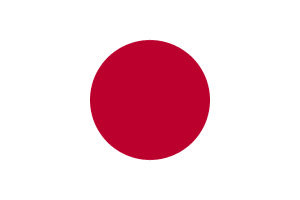
| Colors | HEX Code | RGB | CMYK |
|---|---|---|---|
| White | #FFFFFF | 255, 255, 255 | 0, 0, 0, 0 |
| Crimson Red | #BC002D | 188, 0, 45 | 0, 100, 76, 26 |
The Japanese national flag has a white background with a central crimson disk.
Meaning of the Japanese Flag
The red disk in the middle of the flag represents the sun which has been the symbol of Japan for centuries. The red color also stands for sincerity, brightness, and warmth. The white color stands for purity and integrity. The rising sun also symbolizes the growth and improvement in Japan.
History of the Japanese Flag
The relationship between Japan and the sun that rises on its land is an ancient one. The sun represents goddess Amaterasu, the goddess of the Sun who established Japan in the 7th century BC. The first recorded reference to the Japanese Emperor as the “Emperor of the Sun” was in the 7th-century text “Nihon Shoki” (Chronicles of Japan). Japan also is called “The Land of the Rising Sun.” However, Japan did not have a unified flag for all its lands. Different Japanese lords raised different flags to represent their lands. The first attempt to raise a unified flag of Japan was in the year 1854 when the flag of the rising sun was raised on all Japanese ships. Later in 1870, the flag became official, but it lost its status in 1885 when the new Japanese government changed its laws. The flag was still used for communications with the outside world. It was also used in different wars, like the Sino-Japanese War, the Russo-Japanese War, and WWII. In 1999, the flag laws were updated, and it was adopted as the national emblem of Japan.